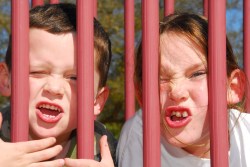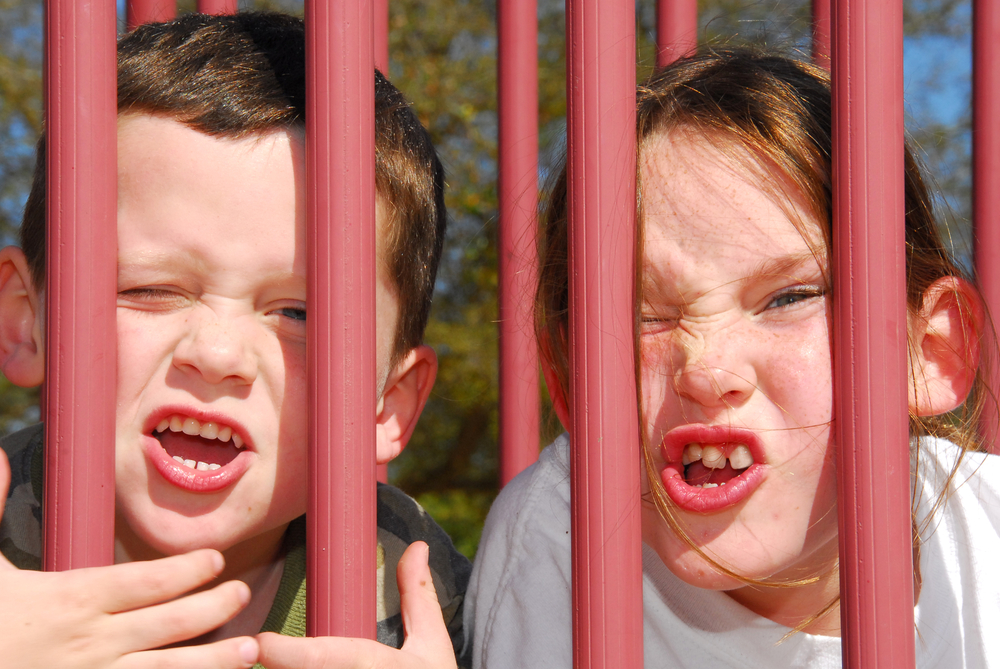
Let us out! (Photo by Shutterstock.)
If you were still watching cartoons at the turn of the millennium (guilty), you may remember a delightful series called Recess, which chronicled the adventures of a group of fourth-graders during that most hallowed time of the school day. For TJ, his friends, and the rest of their schoolmates, the recess bell signaled a transition from the world of grown-ups to one ruled by kids, where the playground was their empire and a sixth-grader called King Bob governed from the top of the jungle gym. Epic battles and campaigns could be waged and won within one 22-minute episode, just as, in real life, those few minutes of recess were time enough to break hearts or body parts.
In recent years, though, a return to school hasn’t necessarily meant resuming the recess routine. Not only do kids these days get a scant amount of daily rigorous activity (which decreases as they get older, studies show), but schools now skimp on recess time to focus on standardized-test prep.
The good news? In some schools, recess is making a comeback.
Recess may have been an exaggerated version of the worlds kids create and inhabit, but it wasn’t all fantasy. Research has shown that play, the most basic and timeless of childhood activities, teaches valuable social and emotional skills, reports LiveScience — things like empathy, imagination, and conflict resolution. The kids on Recess essentially lived in a self-created microcosm of the adult universe, and in many ways, that’s exactly what kids do when they play: mimic and practice adult behavior.
But sadly, kids are getting less and less time to do this, as David Bornstein writes in a recent article in The New York Times:
In decades past, when neighborhoods were perceived to be safe, children had lots of time to play outdoors, and they naturally picked up the culture of play from older kids. Today, children are indoors more and “personal use media” takes up six or seven hours of their time every day (pdf). Young people between the ages of 10 to 16 engage in vigorous activity for only 12.6 minutes per day — nowhere near the 60 minutes that the surgeon general recommends. And the kids who are regularly active typically participate in sports leagues run by adults.
A lot of social shifts could take responsibility for this decline in play: neighborhoods that have too much crime and traffic and not enough eyes on the street, or nearby green space, for kids to run around safely; more families headed by single parents, or by two working parents, means more latchkey kids stuck in after-school programs or shielded inside with “personal use media.”
Regardless of the root cause, a lack of physical activity can be bad news for kids not just physically and socially, but academically as well — ironic when you consider that many schools have shortened or even ended recess in recent years so that kids can spend more time doing test prep.
To make matters worse, often the kids who need recess the most are the ones getting less of it. According to the National Center for Education Statistics, as of 2005, first graders got an average of 28 minutes of recess per day, including lunchtime. But that number decreases the larger and more urban a school is, the higher its minority enrollment, and the higher the number of students eligible for free lunch. A 2009 study in the journal Pediatrics found the same thing:
Children who did not receive scheduled recess at school were more likely to be from lower-income families and from black and Hispanic ethnic groups. This raises concern, in light of evidence that many children from disadvantaged backgrounds are not free to roam their neighborhoods or even their own yards unless they are accompanied by adults.
Another reason that schools cut recess time is the huge number of disciplinary problems that occur during recess and lunch — problems that could be attributed to the dearth of playtime in kids’ lives outside of school, which prevents them from learning the social norms that make play fun. It becomes a chicken-and-egg dilemma: Kids don’t play enough outside of school, which means they don’t know how to play nice at school, which leads to their in-school playtime getting cut, which decreases their already limited opportunities for play even further. TJ and the Recess crew would be horrified.
So what’s the solution? Some schools have found success with groups like Playworks, which employs “play coaches” to facilitate recess in a way that helps kids learn those norms and cues they haven’t had the chance to pick up on their own. The idea of “play coaches” sounds strange — almost dystopian — at first, but they’ve made a huge difference in some schools, Bornstein writes in the Times:
Within about three months, [principals] say, playgrounds in which a quarter or a third of children were previously involved in play become like anthills of activity, with 80 or 90 percent of the kids involved in games by choice. As a result, they contend that their playgrounds are safer and their schools feel more relaxed.
A group called Peaceful Playgrounds aims to minimize conflicts during recess, and maximize the benefits kids get from it, by changing the design of playgrounds themselves, with games and activities that are painted onto existing surfaces. The Arizona Daily Star reports that after implementing the new design, local schools saw significant drops in disciplinary incidents.
Parents and educators across the country have also been advocating for the return of recess, with some success. Last year, spurred by the campaign of a parent group called Raise Your Hand, Chicago Public Schools released guidelines [PDF] for how its elementary schools could incorporate recess back into the school day (Raise Your Hand calculated that only 37 percent of grade schools in Chicago had any form of recess at all), and some of them did — although the changes were yet another point of contention between the teachers’ union and Mayor Rahm Emanuel.
Perhaps, over time, this effort to reintroduce physical activity into the school day could work its way back into the rest of our lives, including the way we design our communities. If we lived in neighborhoods designed for people, not cars, with safe, clean parks within walking distance of every family, kids would come to school knowing how to play games that don’t just take place on a screen. As TJ would say: “Tender.”




